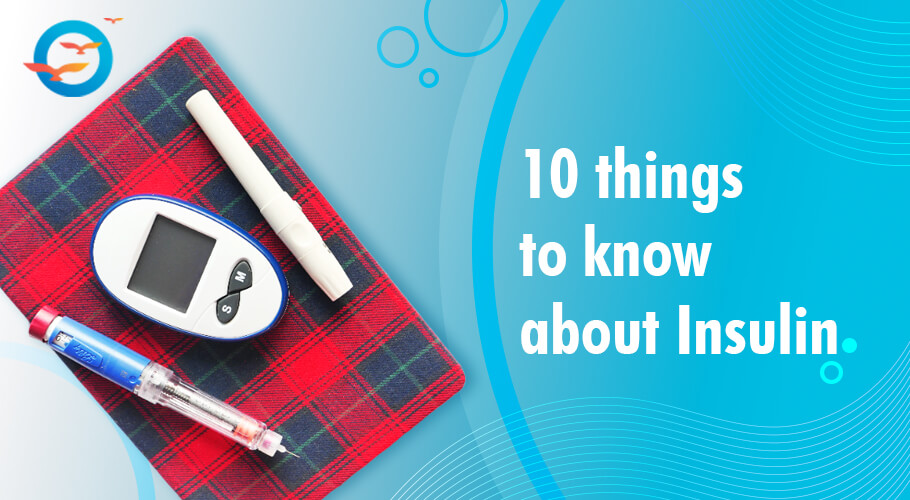10 Things to Know About Insulin Regular Human Solution Usage

Insulin is a hormone made in your pancreas. Its primary function is to transfer glucose from your bloodstream into your body’s cells, where the glucose is converted into energy. Sometimes, the body is unable to produce sufficient insulin or becomes resistant to its own insulin.
This leads to glucose accumulating in the bloodstream, which in time leads to diabetes. Insulin Regular human is used in conjunction with a healthy diet and exercise to normalize blood sugar levels in patients with Type 1 or Type 2 Diabetes.
It is a short-acting, artificial insulin that is similar to the insulin made in your pancreas. It has the same response to glucose and is used to control BSL and prevent diabetes complications. There is little doubt that insulin is a lifesaver for millions of diabetics worldwide. But, like all prescription drugs, it should be used with care to avoid potentially life-threatening situations.
Here are 10 things every user ought to know about insulin regular human injection usage.
1. Get familiar with preparations, usage, and storage
Always read all the information provided along with the medication. If there is any doubt, always get it cleared by your doctor or pharmacist before using the formulation. Do not change brands of insulin unless advised by your doctor. Do not mix different types of insulin, unless prescribed by the doctor. If this has been prescribed to you, ensure you are well informed about the proper way to mix and inject the mixture.
Insulin must be stored as directed. Exposure to heat or light can damage the solution. So, ensure you keep the medicine in a cool, dark place. If there are other insulin users in the home, make arrangements to store the insulin separately so they don’t get mixed up. Do not freeze insulin. And above all do not use it past its expiry date.
2. Administer only as directed
This medication must not be given in an insulin pump. It must be injected under the skin about half an hour prior to meals. Any delay in having the meal can lead to low blood sugar.
If injecting Insulin regularly into a vein, it should only be done by a doctor or healthcare professional, as there is a risk of very low blood sugar if proper precautions are not taken.
3. Visually check the product to ensure correctness
Insulin regular human injection is a clear and colorless liquid. You must check the vial visually to ensure there are no particles or any discoloration. If you notice either, you must not use the injection.
Contact your pharmacist and inform them immediately, so they can take appropriate action. It is possible that the entire batch is bad. In which case, it should be recalled by the manufacturer.
4. Calculate your insulin dose accurately and regularly
As this is a short-acting medicine, users must carefully calculate the volume of glucose in their meals, as well as the amount of physical activity they have done or intend to do.
Mistakes in these calculations, for instance, overestimating the calories/carbohydrates in your meal can lead to hypoglycemia, which is a potentially life-threatening situation.
On the other hand, underestimating your insulin dose can lead to hyperglycemia (high blood sugar). Each dose must be carefully measured as even a small change can have a big effect on your BSL.
5. Keep detailed records
Monitor your BSL at regular intervals. And share the same with your doctor. These records are important to determine the optimum insulin dose. Changes in diet, fitness or any aspect of your daily routine have a direct effect on the dose that is needed.
This is why every participant in FFD’s diabetes reversal has 24x7 access to a doctor. The doctor monitors the participant’s progress/response to the medicine and adjusts dose as needed so there is no danger of over- or under-dosing.
6. Be aware of any side effects
Your doctor will have prescribed this medicine with the full knowledge of your individual medical history, so there are unlikely to be any severe contraindications.
However, there is always the possibility of side effects, as mentioned below. If you notice any of the following, immediately inform your doctor or medical expert and follow their instructions
- Pain, swelling, or irritation at the injection site.
- Unexplained weight gain.
- Muscle cramps, irregular heartbeat, or persistent weakness: could be due to low potassium levels in the blood.
Sudden sweating, shakiness, speeded-up heartbeat, blurred vision, tingling extremities: These are all symptoms of hypoglycemia or low blood sugar. If you notice such symptoms, immediately consume a glucose tablet or gel or any source of sugar, e.g. table sugar, candy, fruit juice. And follow up by informing your doctor.
Insatiable thirst, increased urination, confusion, drowsiness, fruity-smelling breath: These are symptoms of high blood sugar. Inform your doctor right away. Your dose probably needs to be increased.
Although rare, there may also be allergic reactions— rash, itching, swelling of tongue, throat, difficulty breathing. If you notice any of these or any other inexplicable symptoms, contact your doctor right away.
7. Take necessary precautions
There are some precautions you must take when you’re on insulin. Most of these are just plain common sense, but others have a scientific/medical basis, so it is advisable to be aware of them from the outset.
Here are the more common precautions.
- Do not use insulin if your blood sugar is already low.
- If you experience blurred vision, drowsiness, etc. after taking the insulin, do not drive, or operate heavy machinery or undertake any activity that requires you to be alert.
- Do not consume alcohol whilst on insulin—or reduce consumption—as it can raise the risk of low blood sugar.
- If you’re traveling, inform your doctor; and carry extra supplies with you
If you find yourself pregnant or are planning to get pregnant, inform your doctor, as your medication may require adjusting.
8. Tell your doctor of any other drugs you may be on
When you take two or more drugs concurrently, there are interactions, some of which might affect you adversely.
So it is important to keep a list of all the medications you are on—including herbal ones—and inform your doctor when he is prescribing any medicine. Never begin a new course of medication or stop one, without informing your doctor.
9. Know what to do in the event of an overdose
Unfortunately, the risk of overdosing on insulin is high, given that the dosage depends on multiple factors, including the composition and quantity of your meal, any delay in your meal, physical activity you may have performed or are going to perform, time of day, season, etc.
Whatever the reason, you must always be prepared in the event of an overdose. If the symptoms are not severe you will be able to have a glucose tablet, gel or sweet yourself. Rest for a bit, re-hydrate, and then visit your doctor, so he can determine the underlying cause.
If the symptoms are severe and the diabetic falls comatose, it falls to bystanders to administer aid. To ensure they do the right thing, ensure you always carry a card that identifies you as diabetic; lists symptoms; and advises correct treatment; also carry a list of numbers to call.
Every diabetic on insulin must also make it a point to carry a glucagon kit—this consists of liquid glucose, a disposable syringe, and needles. The glucose can be quickly administered to ward off the effects of hypoglycemia. Sometimes the patient may need to be hospitalized, if only for observation.
10. Be consistent in usage
For best results, use the medication regularly, as advised by the doctor. This means using it at the same time of the day every day. Also, ensure you keep a detailed log of your use to quickly understand whether your dose is correct or needs adjusting or if the medication is working as needed. In the event that your condition doesn’t improve, or worsens, the log will help you stay informed.

